Cucurbit[6]uril-based supramolecular frameworks assembled via the outer surface interaction of cucurbit[n]urils
2021-04-02ChaoLiuRuihanGaoYunqianZhangQianjiangZhuZhuTao
Chao Liu,Ruihan Gao,Yunqian Zhang,Qianjiang Zhu,Zhu Tao*
Key Laboratory of Macrocyclic and Supramolecular Chemistry of Guizhou Province, Guizhou University, Guiyang 550025, China
ABSTRACT Curcurbit[n]uril (Q[n])-based supramolecular frameworks (QSFs) constructed from the outer surface interaction of Q[n]s (OSIQ) have the characteristic of simplicity, diversity and modulability.Their simplicity is reflected in their simple composition and preparation methods used for QSFs.The diversity of supramolecular organic frameworks (SOFs) is reflected in the synthesis methods and structural characteristics of the as-obtained QSFs, as well as the variety of structural directing agents and basic building blocks used to prepare QSFs.The modulability is reflected by the controllable channel size in the QSFs,which can be adjusted using different sizes of Q[n]s.In this work,the first reported cucurbituril Q[6]was selected as the basic building block and three Q[6]-based supramolecular frameworks were obtained from aqueous HCl solutions in the presence of [CdCl4]2- respectively.The OSIQs are the main driving forces for the formation of these frameworks.This study shows the diversity of the QSFs.
Keywords:Cucurbit[6]uril[CdCl4]2- anion Structure directing agent Outer surface interaction of Q[6]s Supramolecular frameworks
Cucurbit[6]uril (Q[6]) was the first member of the cucubit[n]-uril (Q[n]) family to be reported [1], Q[6] is formed via the condensation of glycoluril and formaldehyde in acidic media.Q[6]is constructed from six glycolurils bridging through twelve methylene groups and has a central empty cavity with two open portals rimmed with six carbonyl groups,respectively(Fig.1,left).To date,the Q[n]-family has more than 100 members,ranging from the smallest Q[4] analogues [2,3] to the largest twisted cucurbit-[15]uril (tQ[15]) [4], which are available from the common to partially and fully alkyl-substituted Q[n]s.The rigid structure,the electrostatic potential negative carbonyl rimmed portals, neutral cavity and the positive outer surface make Q[n]s suitable as the basic building block of Q[n]-based supramolecular assemblies,polymers and frameworks (Fig.1, right) [5-11].
The research of Stoddart [12-14], the 2016 Nobel laureate in Q[n]-based supramolecular self-assembly chemistry, and Fujita and Yaghi [15-19], the 2018 Wolf Prize winners in coordination frameworks and reticular chemistry,have significantly contributed to the rapid development of cucurbitu[n]uril(Q[n])-based frameworks [20] driven by different interactions, including the coordination of electrostatic potential negative portal carbonyl oxygen atoms to metal ions [5,6], the electrostatic potential neutral cavity inclusion of Q[n]s for guests [7-9], and the electrostatic potential positive outer surface interaction of Q[n]s(OSIQ) [10,11], and other supramolecular interactions.The OSIQs have received a great deal of attention in recent years [11,21].Among the three main driving forces, the OSIQs are the most important because they are ubiquitous, not only in OSIQ-induced Q[n]-based frameworks,but also in Q[n]-based frameworks driven via the coordination or host-guest inclusion.According to the different species interacting with the electrostatic potential positive outer surface of Q[n]s, the OSIQs can be mainly divided into:1)the self-induced OSIQ because of the interaction with the electrostatic potential negative portal carbonyl oxygen atoms of adjacent Q[n]s; 2) the anion-induced OSIQ due to the interaction with negative anions,especially inorganic anions;3)the aromaticinduced OSIQ due to the interaction with organic compounds containing aromatic rings.Moreover,the OSIQ-induced Q[n]-based frameworks have the characteristic of simplicity, diversity and modulability.Their simplicity is reflected in the simple composition and preparation methods used for Q[n]-based supramolecular frameworks (QSFs).The diversity of supramolecular organic frameworks(SOFs)is reflected in the variety of synthesis methods and structural characteristics of the as-obtained SOFs as well as the variety of structural directing agents and basic building blocks used to prepare QSFs.The modulability is reflected by the controllable channel sizes in the QSFs, which can be adjusted using different sizes of Q[n]s.Although there are a number of reports on OSIQ-induced Q[n]-based frameworks, there are few and scattered discussions on the construction strategies and principles of OSIQ-induced Q[n]-based frameworks, which are crucial for the development of Q[n]-based framework chemistry and its potential applications.
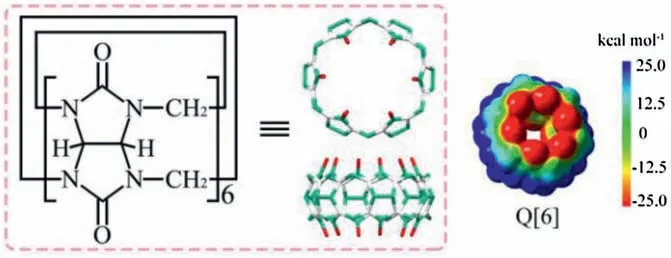
Fig.1.Structures of Q[6](left)and electrostatic potential map(ESP)for Q[6](right).ESP is mapped on electron density isosurfaces(0.001 e/au3)for Q[6]at the B3LYP/6-311 G (d, p) level of theory from Gaussian09 calculations.
In this work,Q[6]was selected as building block to examine the diversity of the OSIQ-induced Q[n]-based frameworks,with CdCl2used to produce polychlorocadmate anions in aqueous HCl solutions, which play the role of a structure directing agent.Q[6]-CdCl2-HCl systems prepared using different proportions of its components formed three different Q[6]-based supramolecular frameworks (QSFs 1-3).The synthetic procedures are detailed in Supporting information.QSF 1 was obtained using a 3 mol/L aqueous HCl solution and a 1:6 molar ratio of Q[6]:CdCl2·2.5H2O[22].QSF 2 was obtained using a 3 mol/L aqueous HCl solution and a 1:6 molar ratio of Q[6]:CdCl2·2.5H2O,which was heated at reflux for 5 min prior to cooling to room temperature.QSF 3 was obtained using a 6 mol/L aqueous HCl solution and a 1:12 molar ratio of Q[6]:CdCl2·2.5H2O, which was heated at reflux for 5 min prior to cooling to room temperature.Thus, the Q[6]-CdCl2-HCl system exhibits the diversity of QSFs because of the different experimental conditions, proportions of the components and concentrations of HCl solution used.
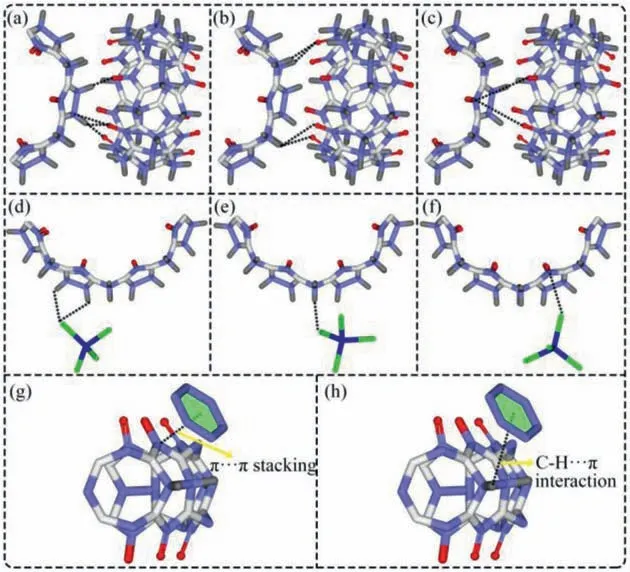
Fig.2.Representative OSIQs formed between (a-c) two neighboring Q[n]molecules, (d-f) an anion and neighboring Q[n] molecule, and (g, h) an aromatic molecule with a neighboring Q[n] molecule.
OSIQs for the formation of these QSFs may be the main driving forces and can be divided into three catagories: self-induced,anion-induced, and aromatic-induced OSIQs.Generally, selfinduced OSIQs include the dipole interactions formed between the electrostatic potential negative portal carbonyl groups in Q[n]s or oxygen atoms in water molecules with the electrostatic potential positive methine and bridged methylene, and portal carbonyl carbon atoms in the adjacent Q[n]molecules( Figs.2a-c);anion-induced OSIQ includes ion-dipole interactions formed between anions and the electrostatic potential positive methine and bridged methylene, and portal carbonyl carbon atoms in the adjacent Q[n] molecules ( Figs.2d-f); the aromatic-induced OSIQ includes the interaction of aromatic compounds, especially those containing carboxyl groups, with the electrostatic potential positive outer surface of Q[n]s via hydrogen bonding,π···interactions, and C-H···π interactions ( Figs.2g and h).In the present work,the aromatic compounds have not been introduced into the systems;therefore the aromatic-induced OSIQ would not exist in the QSFs 1-3.
Fig.3a shows the overview of the QSF 1, which exhibits numerous one-dimensional channels with an average crosssection of ca.20 Å2along the a-axis [22].Each channel is constructed from four Q[6] molecule strings, which are linked by the[CdCl4]2-anions via the anion-induced OSIQ(Fig.3b).QSF 1 can be also seen as a combination of the Q[6]-based (Fig.3c) and[CdCl4]2--based(Fig.3d)frameworks.In QSF 1,each Q[6]molecule interacts with four adjacent Q[6] molecules via the self-induced OSIQ, including dipole interactions formed between the electrostatic potential negative portal carbonyl oxygen atoms in the Q[6]molecules and the electrostatic potential positive methine and methylene groups in the adjacent Q[6] molecules; the interaction distances of the portal carbonyl oxygens in a Q[6]molecule to the methine (Ocarbonyl-Cmethine) and bridged methylene (Ocarbonyl-Cmethylene) groups of the adjacent Q[6] molecules are in the range of 3.084-3.337 Å (Fig.3e).Moreover, each Q[6]molecule interacts with six adjacent [CdCl4]2-anions via the anion-induced OSIQ, including ion-dipole interactions formed between the electrostatic negative [CdCl4]2-anions and the electrostatic potential positive methine groups and methylene groups, and portal carbonyl carbon atoms in the adjacent Q[6]molecules;the interaction distances between the Cl-ions from the[CdCl4]2-anions and the methine(Cl-Cmethine),bridged methylene(Cl-Cmethylene)and portal carbonyl carbon atoms(Cl-Ccarbonyl)in the adjacent Q[6]molecules are in the range of 3.356-3.770 Å(Fig.3f).
After heating at reflux for 5 min, the mixed solution used to prepare QSF 1 unexpectedly gave QSF 2 with different structural features.The 5-minute heating process may change the concentration of the system’s components,the acidity of the medium, etc.,leading to the formation of an [Cd4Cl14]6-anion cluster,changing the anion-induced OSIQ formed between the anion clusters and Q[6]molecules,resulting in the formation of QSF 2.Fig.4a shows the overview of QSF 2 which contains rectangle channels with an average cross-section of ca.22 Å2along the a-axis.Each channel was constructed from four Q[6] molecule strings and four[Cd4Cl14]6-anion strings, which play the role of hinges to link the four Q[6]molecule strings via the anion-induced OSIQ(Fig.4b). Figs.4c and d show the QSF 2 without the[Cd4Cl14]6-anions and Q[6] molecules, respectively.There are two kinds of channels observed in the QSF 2 without[Cd4Cl14]6-anions:the larger one is shown in Fig.4a, while the smaller one consists of only four Q[6]molecule strings.It is interesting that the inner wall of the larger channels was modified by the electrostatic potential negative portals of the Q[6] molecules, while the inner wall of the smaller channels was modified by the electrostatic potential positive outer surface of the Q[6]molecules.The[Cd4Cl14]6-anion strings shown in Fig.4d are embedded in the small channels shown in Fig.4c.Moreover, in QSF 2 without [Cd4Cl14]6-anions, the self-induced OSIQ exists among the adjacent Q[6] molecules.For example,dipole interactions are formed between the portal carbonyl oxygen atoms of a Q[6] molecule and the methine units of four Q[6]molecules in four adjacent Q[6]-based strings(3.378-3.504 Å),and dipole interactions are formed between the portal carbonyl oxygen atoms of a Q[6]molecule and the methylene groups in the adjacent Q[6] molecules in the same Q[6]-based string (3.378-3.504 Å,Fig.4e).Furthermore, each Q[6] molecule interacts with four adjacent[Cd4Cl14]6-anions via the anion-induced OSIQ,including ion-dipole interactions between the [Cd4Cl14]6-anions and the methine and methylene groups of the central Q[6] molecule; the interaction distances of Cl-Cmethineand Cl-Cmethyleneare in the range of 3.358-3.742 Å, (Fig.4f).
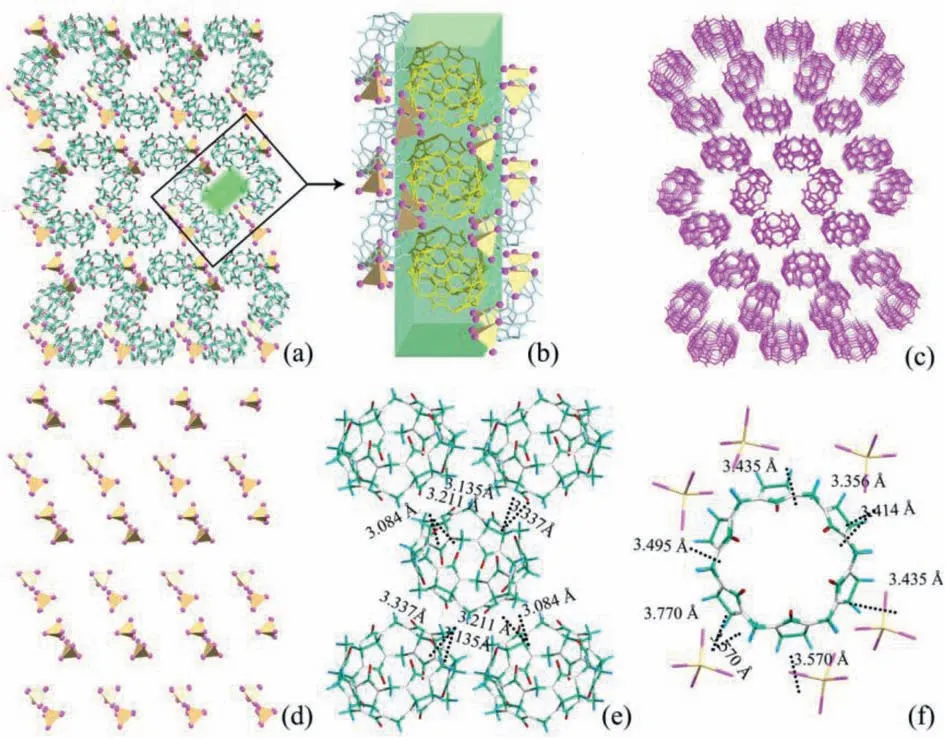
Fig.3.(a)The crystal structure of QSF 1;(b)the channel constructed from Q[6]molecules and[CdCl4]2-anions;(c,d)QSF 1 omitting the[CdCl4]2-anions and Q[6]molecules,respectively; (e, f) detailed self-induced and anion-induced OSIQs of a Q[6] molecule with its adjacent Q[6] molecules and [CdCl4]2- anions, respectively.
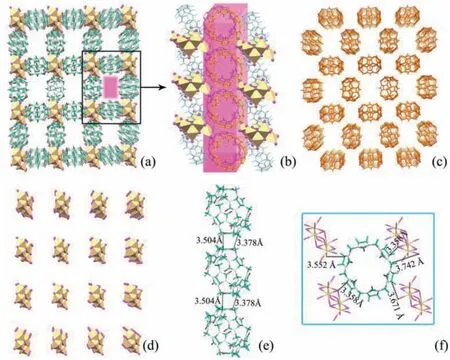
Fig.4.(a)The crystal structure of QSF 2;(b)a channel constructed from the Q[6]molecules and[Cd2Cl7]3-anions;(c, d)QSF 2 omitting[Cd2Cl7]3-and Q[6],respectively;(e, f)detailed self-induced and anion-induced OSIQs of a Q[6] molecule with its adjacent Q[6] molecules and [Cd2Cl7]3- anions, respectively.
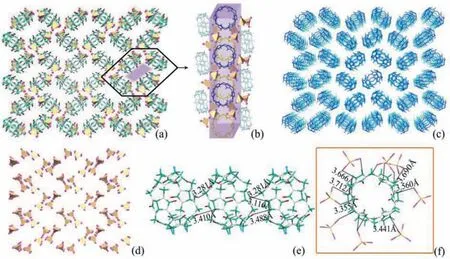
Fig.5.(a)The crystal structure of QSF 3;(b)the channel constructed from Q[6]molecules and anions;(c, d)QSF 3 omitting[CdCl4]2-and Q[6],respectively;(e, f)detailed selfinduced and anion-induced OSIQs of a Q[6] molecule with its adjacent Q[6] molecules and [CdCl4]2- anions, respectively.
Upon increasing the concentration of HCl(6 mol/L)and the ratio of CdCl2to Q[6](12:1),the Q[6]-CdCl2-HCl system produced QSF 3,which was constructed from Q[6]molecules and[CdCl4]2-anions in a 1:2 ratio.Fig.5a shows an overview of QSF 3,which contains parallelogram channels with an average cross-section of ca.13 Å2along the a-axis.Every four Q[6] molecule strings construct a channel and the[CdCl4]2-anions play the role of hinges to link the adjacent Q[6] molecules not only in the same Q[6]-based string,but also adjacent Q[6]-based strings via the anion-induced OSIQ(Fig.5b).Similarly, QSF 3 can be decomposed into a Q[6]-based(Fig.5c)and[CdCl4]2--based(Fig.5d)framework.Surprisingly,in QSF 3 only a limited number of adjacent Q[6] molecules, namely those in the vertical sub-type, have the self-induced OSIQ, as shown in Fig.5c,that is,the Q[6]molecules between the vertical zig-zag Q[6]-based strings as shown in Fig.5c.Fig.5e shows the detailed self-induced OSIQ in the adjacent Q[6] molecules; the interaction distances between the portal carbonyl oxygens of a Q[6] molecule to the methine (Ocarbonyl-Cmethine), methylene(Ocarbonyl-Cmethylene), and portal carbonyl carbon atoms(Ocarbonyl-Ccarbonyl) of its adjacent Q[6] molecules were in the range of 3.116-3.488 Å.Moreover, each Q[6] molecule interacts with eight adjacent[CdCl4]2-anions via the anion-induced OSIQ,including ion-dipole interactions formed between the electrostatic negative [CdCl4]2-anions and the electrostatic potential positive methine and methylene groups,and portal carbonyl carbon atoms in the adjacent Q[6]molecules;the interaction distances between the Cl-ions from the[CdCl4]2-anions to the methine(Cl-Cmethine),bridged methylene (Cl-Cmethylene) and portal carbonyl carbon(Cl-Ccarbonyl) atoms in the adjacent Q[6] molecules were in the range of 3.355-3.712 Å (Fig.5f).
It should noted that we have omitted the latticed water molecules, which generally play an important role in the construction of QSFs via hydrogen bonding of the portal carbonyl oxygen atoms in the Q[6]molecules and are most likely to be in the channels of these QSFs,but we have not specifically discussed their existence, given that they are usually removed when considering the use of these QSFs.In addition,it should be noted that the inner walls of the channels in the QSFs is modified by the portal carbonyl oxygen atoms, which seems to be a common feature of the three QSFs induced by polychlorocadmate anions,which always interact with the electrostatic potential positive outer surface of Q[6]molecules.
In summary, we have used a Q[6]-CdCl2-HCl system to obtain three QSFs (1-3) with different structures by changing the proportion of its components, acid concentration, reaction temperature and other conditions.The experimental results not only confirm the structural directing effect of polychlorocadmate anions generated in the preparation process,but also demonstrate the diversity of the QSFs obtained via the anion-induced OSIQs.X-ray analysis indicated that two of three main OSIQs,namely the self-induced and anion-induced OSIQs formed between adjacent Q[6] molecules and the Q[6] molecules and polychlorocadmate anions are the main driving forces resulting in the formation of three QSFs(1-3).The driving forces include the dipole interactions formed between the portal carbonyl oxygens of a Q[6] molecule and the methine, bridged methylene and portal carbonyl carbon atoms of its adjacent Q[6] molecules, as well as the ion-dipole interaction formed between the methine, bridged methylene,portal carbonyl carbon atoms of a Q[6] molecule and its adjacent polychlorocadmate anions.Moreover, the inner walls of the channels in these frameworks are decorated with the portal carbonyl oxygen atoms of the Q[6]molecules due to the affinity of polychlorocadmate anions to the outer surface of the Q[6]molecules.This provides an important basis for the further investigation of the functional properties of these QSFs.
Declaration of competing interest
The authors declare no competing financial interest.
Acknowledgments
We acknowledge the financial support of the National Natural Science Foundation of China (Nos.21761007, 51663005 and 21871064), Science and Technology Plan Project of Guizhou Province (Nos.20175788 and 20185781).
Appendix A.Supplementary data
Supplementary material related to this article can be found, in the online version, at doi:https://doi.org/10.1016/j.cclet.2020.05.014.
杂志排行
Chinese Chemical Letters的其它文章
- A biomass based photonic crystal made of “konjac tofu”
- Hydrothermal-assisted grinding route for WS2 quantum dots (QDs)from nanosheets with preferable tribological performance
- Superiority of poly(L-lactic acid) microspheres as dermal fillers
- Zwitterionic comb-like lipid polymers encapsulating linalool for increasing the fragrance retention time
- Construction of a nano-rectangular Zn-Nd complex with near-infrared luminescent response towards metal ions
- Synthesis and structure of Au19Ag4(S-Adm)15 nanocluster:Polymorphs and optical properties
